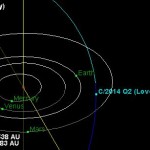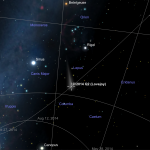Back on August 17th, Australian amateur astronomer Terry Lovejoy disocvered a very nice Christmas gift for us all to enjoy… A bright comet that we have now unwrapped and are able to enjoy through the new year.
Comet C/2014 Q2 Lovejoy is currently passing through perihelion. While closest to the Sun and the Earth it will be at its brightest during the first couple weeks of January. For northern hemisphere observers the comet is currently low in the southern sky and getting brighter each day.

The comet passes through perihelion on January 30th of 2015. For earthbound observers it will be at its brightest during the first weeks of January, reaching near 4th magnitude. It is currently visible around 5th magnitude in the faint constellation of Columba south of Orion. It has been visible without optical aid for a few weeks, as long as you have access to a dark sky and know where to look. As it brightens it will be easily visible, even rather obvious. With binoculars the view will be even better, a bright fuzzball with a wispy tail.

The next thing you may note about the orbital diagram is that the comet has a high inclination to the ecliptic. Currently approaching from underneath the plane of the solar system, the comet will exit north of our Sun. The practical side of this, is that over the next few weeks the comet will move northwards across the sky, rising higher each night. While our friends down south have been enjoying nice views of the comet approaching perihelion, it is northern hemisphere observers that will be able to best view the comet after perihelion.

One issue will be the bright Moon. Currently a waxing half phase, the Moon will be full on January 4th. This will make spotting the comet much more difficult and completely drown out the faint tail. By 9th or 10th the Moon will have waned enough to make comet viewing much more successful.
As January fades, so will comet C/2014 Q2. By the end of the month the comet will slip below unaided eye visibility, while staying within reach of binoculars through April or so. Sky watchers will be able to follow the comet for months betond that with the aid of a telescope. Enjoy the comet while you can, 8,000 years will pass before this comet returns to the inner solar system.


Thanks for that andrew
aloha